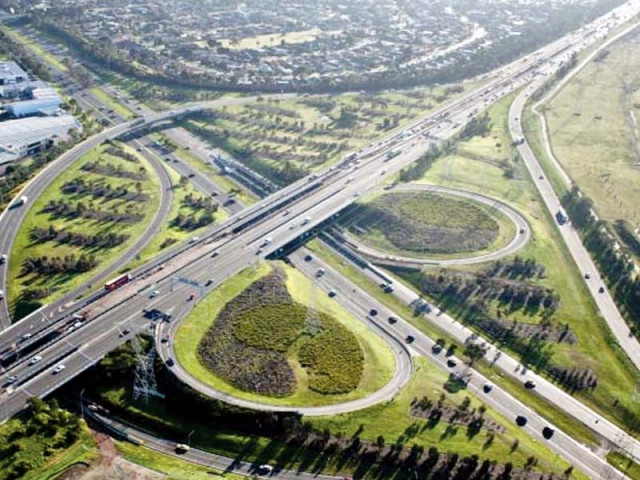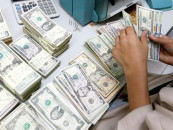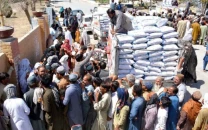New government but old economic crisis
Currency volatility, rising deficit, fiscal woes exacerbate economic challenges

The economy is trapped in a vicious cycle as the balance of payments crisis emerges after every few years.
Even though the government has changed, the economic challenges remain the same. The volatility in the currency exchange rate, the rising current account deficit and the challenges on the fiscal front at a time when political temperatures rise exacerbate the economic challenges.
The current account deficit, as reported by the State Bank of Pakistan (SBP), for the first eight months of FY22 surpassed $12 billion. The current account was in surplus in the first eight months in the previous fiscal year.
While receipts of exports of goods and services and remittances increased by approximately $8 billion, the payments on imports of goods and services increased by around $20 billion in the same time period.
The foreign currency reserves at the SBP decreased to $11.3 billion on April 1, 2022 from $16.2 billion on March 4, 2022. However, with the new government in place, the foreign reserves situation is expected to improve once the country receives the next loan tranche from the IMF.
Furthermore, the recent hike of 250 basis points in the policy rate can help boost dollar inflows and further stabilise the foreign exchange reserves held at the central bank. According to statistics provided by the Pakistan Bureau of Statistics (PBS), exports of commodities increased by 26% in the first eight months of FY22 over the same time period of last fiscal year, while imports increased by 55.1%.
The textile group, which contributes approximately 60% of total exports from Pakistan, observed a year-on-year growth of 26.1%. Exports of knitwear increased by 33.9%, or approximately $830 million, and exports of readymade garments increased by 25.1%, or $500 million.
Considering imports of commodities, imports of petroleum group almost doubled year-on-year in the first eight months of FY22, to $12.9 billion.
Although the quantity of petroleum products increased by 22% and quantity of petroleum crude increased by only 1%, the dollar value for the former rose by 116.7% and for the latter by 79.9%.
Furthermore, the dollar value of LNG imports increased by 105%. One-third of the increase in total imports year-on-year is contributed by the increase in imports of items in the petroleum group.
Another major item is the import of medicinal products, which spiked approximately 400%, or $3 billion. The total year-on-year change in value terms for the rest of the commodities is less than $4 billion.
Hence, the imposition of import restrictions is unlikely to reduce the current account deficit as a majority of the goods imported are likely essential.
Although the value of imports of petroleum products is likely to be dictated by world prices, the lack of productivity and inefficiencies in converting input into output are contributing factors to the large imbalance between exports and imports.
According to the World Bank’s World Development Indicators, Pakistan’s exports as a percentage of gross domestic product (GDP) were approximately 10% in 2020, one of the lowest in the world.
This is particularly disconcerting given that Pakistan faces regular balance of payments crisis and requires dollar inflows from exports to increase the foreign exchange reserves.
Imports, as a percentage of GDP at 17.5% in 2020, were relatively low. The weighted average tariff rate on all products, at 8.7%, is not only higher than the South Asian average but is more than three times the average reported by the East Asian and Pacific countries.
The manufacturing powerhouses in East Asia and the developed world are replacing tariff measures with technical non-tariff measures that focus on ensuring that their imports meet certain standards. This strategy not only discourages imports of substandard goods but is also important in enhancing consumer welfare.
One of the biggest challenges for the government policymakers that want to revive economic activity is the shrinking size of the manufacturing sector relative to the country’s GDP.
Although several experts may suggest that economy activity is shifting towards the services and construction sectors, it is unlikely that the shift is contributing to productivity gains.
Competitors
It is also important to note that the lesser developed regional competitors, such as Bangladesh, Vietnam and Cambodia, have all observed growth in the manufacturing value added as a percentage of GDP in recent years.
The GDP per capita of the three aforementioned countries has grown at a rate of more than 4% between 2010 and 2019, while Pakistan failed to surpass even 3.7% during the decade.
Bangladesh, Vietnam and Cambodia report higher levels of exports as a percentage of GDP relative to Pakistan, with Vietnam reporting a stellar performance in the last 10 years.
On the other hand, exports from Pakistan have remained stagnant, which is a reflection of the lack of productivity and failure to convert input into exportable output that competes well in global and regional markets.
Pakistan remains one of the most protected markets in the world, with the policymakers preferring inward-looking policies that favour import substitution rather than adopting export-orientated policies that are likely to increase global competitiveness of Pakistani products.
For instance, the government has given incentives to the low value-added assembly activities that are unlikely to generate significant value-added exports.
On the other hand, Vietnam has become an important contributor to the global value chains, primarily by opening up trade and attracting foreign investment in productive sectors. As mentioned previously, Vietnam has replaced tariff measures with technical non-tariff measures.
The new government must push for better integration of Pakistan’s economy into the global and regional markets. It should first and foremost improve trading relationships with India.
Imports of textile raw material and intermediate goods from India can further boost domestic production and exports. Also, imports of cheaper agricultural products can help suppress inflationary pressures.
The government must negotiate free trade agreements with Asean member countries and Turkey, while pushing for more trade with Central Asian economies.
Last but not the least, improvements in trading relationships with the US and Europe are a must to further boost export growth. A more proactive trade strategy is a must to tackle the crisis in the long run.
The writer is the Assistant Professor of Economics and Research Fellow at CBER, Institute of Business Administration, Karachi
Published in The Express Tribune, April 25th, 2022.
Like Business on Facebook, follow @TribuneBiz on Twitter to stay informed and join in the conversation.



















COMMENTS
Comments are moderated and generally will be posted if they are on-topic and not abusive.
For more information, please see our Comments FAQ